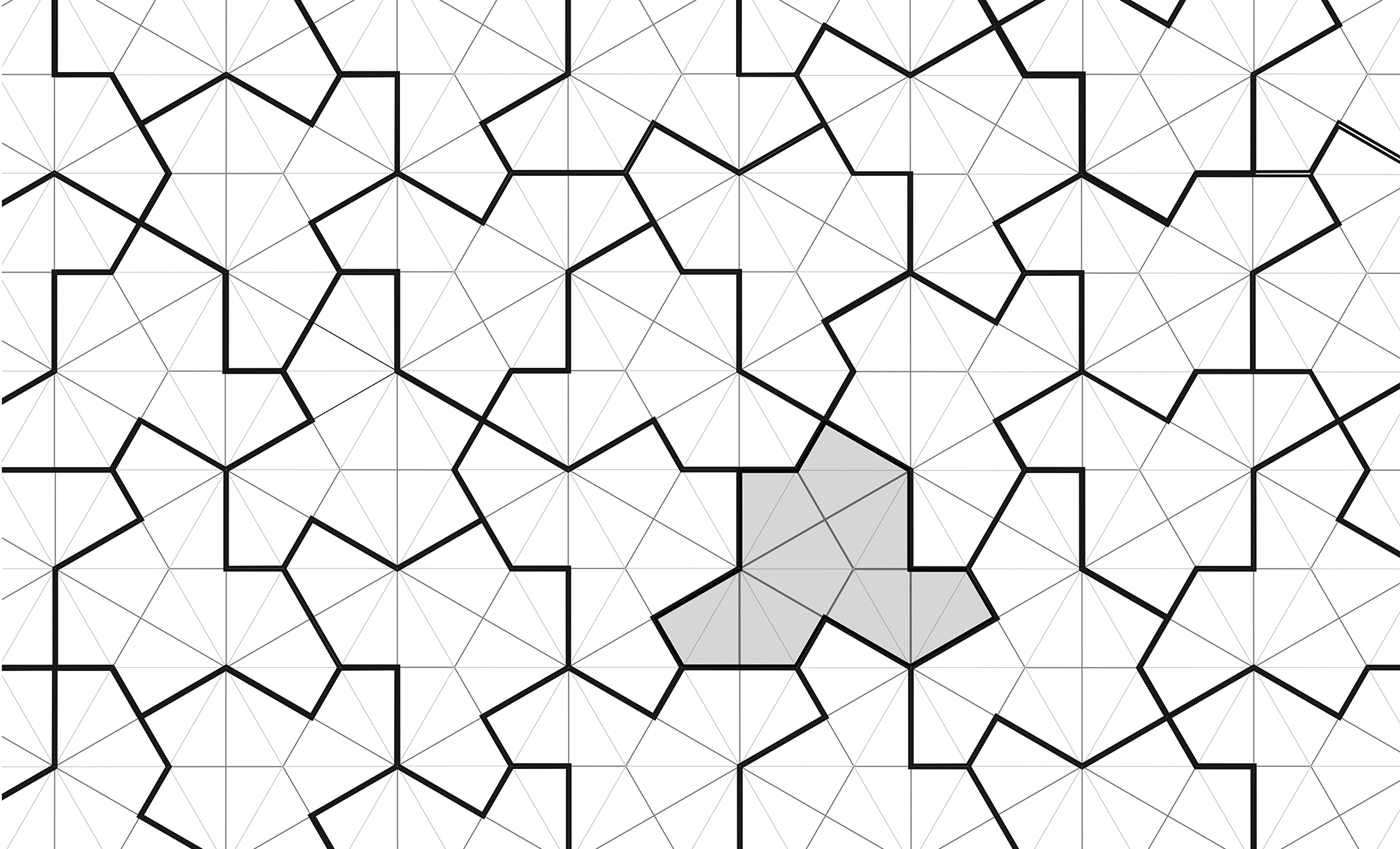Problems
We’ll explore how to tile the plane using rectangles, more general quadrilaterals, pentagons and more unconventional shapes. In this exercise sheet, we define a plane tiling as a covering of the entire plane, without any gaps or overlaps, using identical geometric shapes that can be rotated or reflected to one another. Usually, it is sufficient to cover a small portion of the plane with a particular pattern that we see can be extended to cover the entire plane.
In the majority of today’s problems, one only needs to create a pattern for a small section of the plane, which can then be extended to cover the entire plane through repetition. Such tilings are referred to as periodic. Finding a tiling of the plane using identical shapes that is not periodic, meaning the pattern never repeats itself, has been a long-standing open problem. However, this problem was solved in an article published in March 2023 by David Smith, Joseph Samuel Myers, Craig S. Kaplan, and Chaim Goodman-Strauss. The idea of their solution is the following diagram from the article:

The hard part is to prove that this tiling is aperiodic.
In this example we will discuss division with remainder. For polynomials \(f(x)\) and \(g(x)\) with \(\deg(f)\geq \deg(g)\) there always exists polynomials \(q(x)\) and \(r(x)\) such that \[f(x)=q(x)g(x)+r(x)\] and \(\deg(r)<\deg(g)\) or \(r(x)=0\). This should look very much like usual division of numbers, and just like in that case, we call \(f(x)\) the dividend, \(g(x)\) the divisor, \(q(x)\) the quotient, and \(r(x)\) the remainder. If \(r(x)=0\), we say that \(g(x)\) divides \(f(x)\), and we may write \(g(x)\mid f(x)\). Let \(f(x)=x^7-1\) and \(g(x)=x^3+x+1\). Is \(f(x)\) divisible by \(g(x)\)?
In this example we will discuss division with remainder. For polynomials \(f(x)\) and \(g(x)\) with \(\deg(f)\geq \deg(g)\) there always exists polynomials \(q(x)\) and \(r(x)\) such that \[f(x)=q(x)g(x)+r(x)\] and \(\deg(r)<\deg(g)\) or \(r(x)=0\). This should look very much like usual division of numbers, and just like in that case, we call \(f(x)\) the dividend, \(g(x)\) the divisor, \(q(x)\) the quotient, and \(r(x)\) the remainder. If \(r(x)=0\), we say that \(g(x)\) divides \(f(x)\), and we may write \(g(x)\mid f(x)\). Let \(f(x)=x^7-1\) and \(g(x)=x^3+x+1\). Is \(f(x)\) divisible by \(g(x)\)?
In this example we discuss the Factor Theorem. First, let us recall the following concept: if \(P(x)\) is a polynomial, then a number \(z\), is a root of \(P(x)\) if \(P(z)=0\). For example, \(x=1\) is a root of the polynomial \(Q(x)=x-1\). Show:
If \(0\) is a root of \(P(x)\), i.e: \(P(0)=0\), then \(P(x)=xQ(x)\) for some polynomial \(Q(x)\).
Use part 1 to show the Factor Theorem: if \(z\) is a root of \(P(x)\), then \(P(x)=(x-z)K(x)\) for some polynomial \(K(x)\).
In this example we discuss one of Vieta’s formulae. Consider the polynomial \(P(x)=x^2+5x-7\). You can take it as a fact that this polynomial has exactly two distinct roots. What is the sum of its roots? What about their product?
The polynomial \(P(x)=x^3+3x^2-7x+1\) has three distinct roots: \(a,b,\) and \(c\). What is the value of \(a^2+b^2+c^2\)?
So far we have discussed polynomials in one variable, i.e: with only an \(x\) as our variable. We can however, include as many as we want. For example, we can talk of a polynomial such as \[P(x,y)=x^2-y^2,\] where both \(x\) and \(y\) are variables. This is an example of an antisymmetric polynomial, which means that \(P(x,y)=-P(y,x)\) (i.e: switching \(x\) for \(y\) gives the original polynomial with a minus sign). Conversely, a polynomial \(Q(x,y)\) such that \(Q(x,y)=Q(y,x)\) is called symmetric. Show that every antisymmetric polynomial \(P(x,y)\) can be factored as \[P(x,y)=(x-y)Q(x,y),\] where \(Q(x,y)\) is a symmetric polynomial.
Find the remainder of dividing \(x^{100}-2x^{51}+1\) by \(x^2-1\). Try not to do a long calculation.
Katie and James take turns replacing the stars with any number of their choice in the following polynomial from left to right: \[x^4 +\star x^3+\star x^2+\star x+\star.\] Katie wins if once the game is over, the resulting polynomial has no integer roots (i.e: no roots which are whole numbers). Does James have a winning strategy?
Show that if a polynomial \(P(x)\) has an integer root (i.e: a root that is a whole number), then it can’t be that \(P(0)\) and \(P(1)\) are both odd.